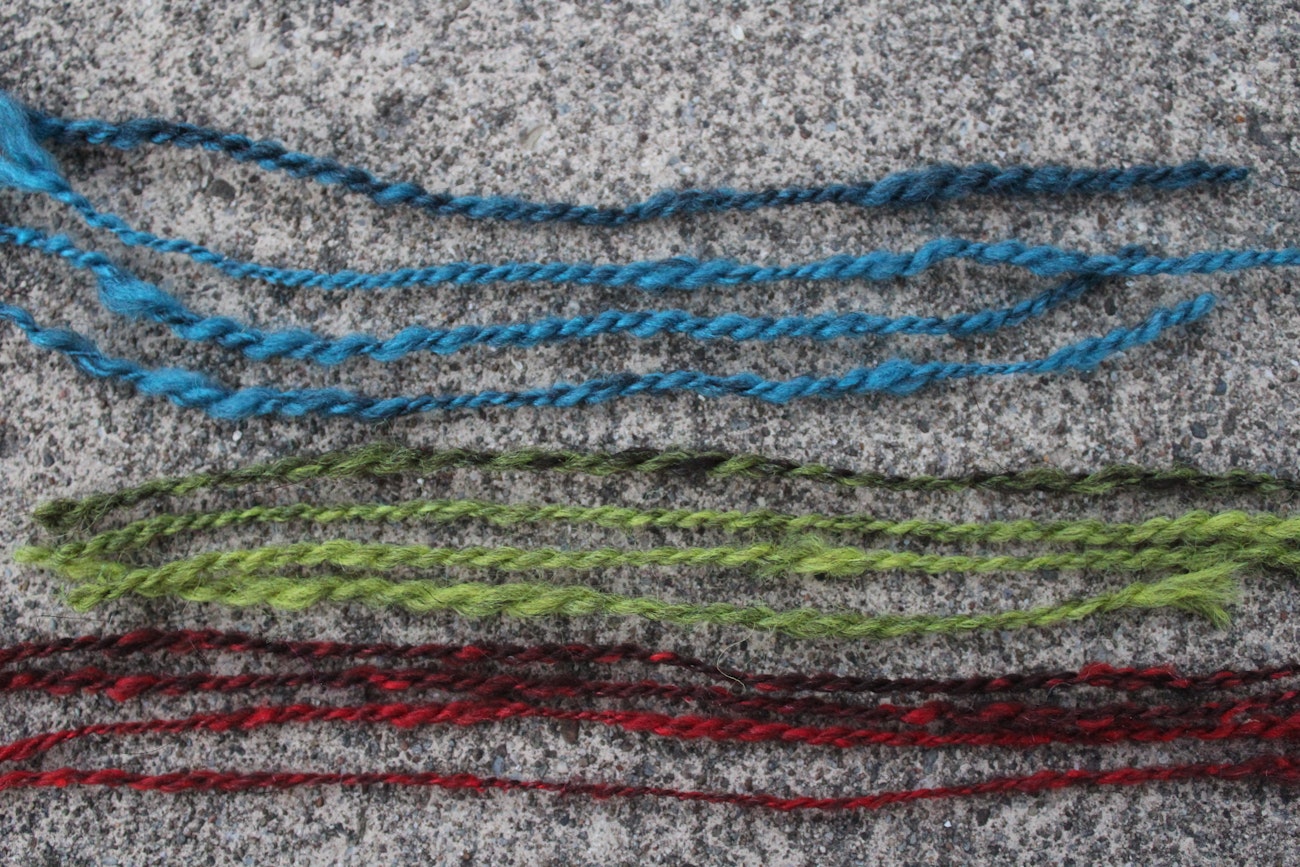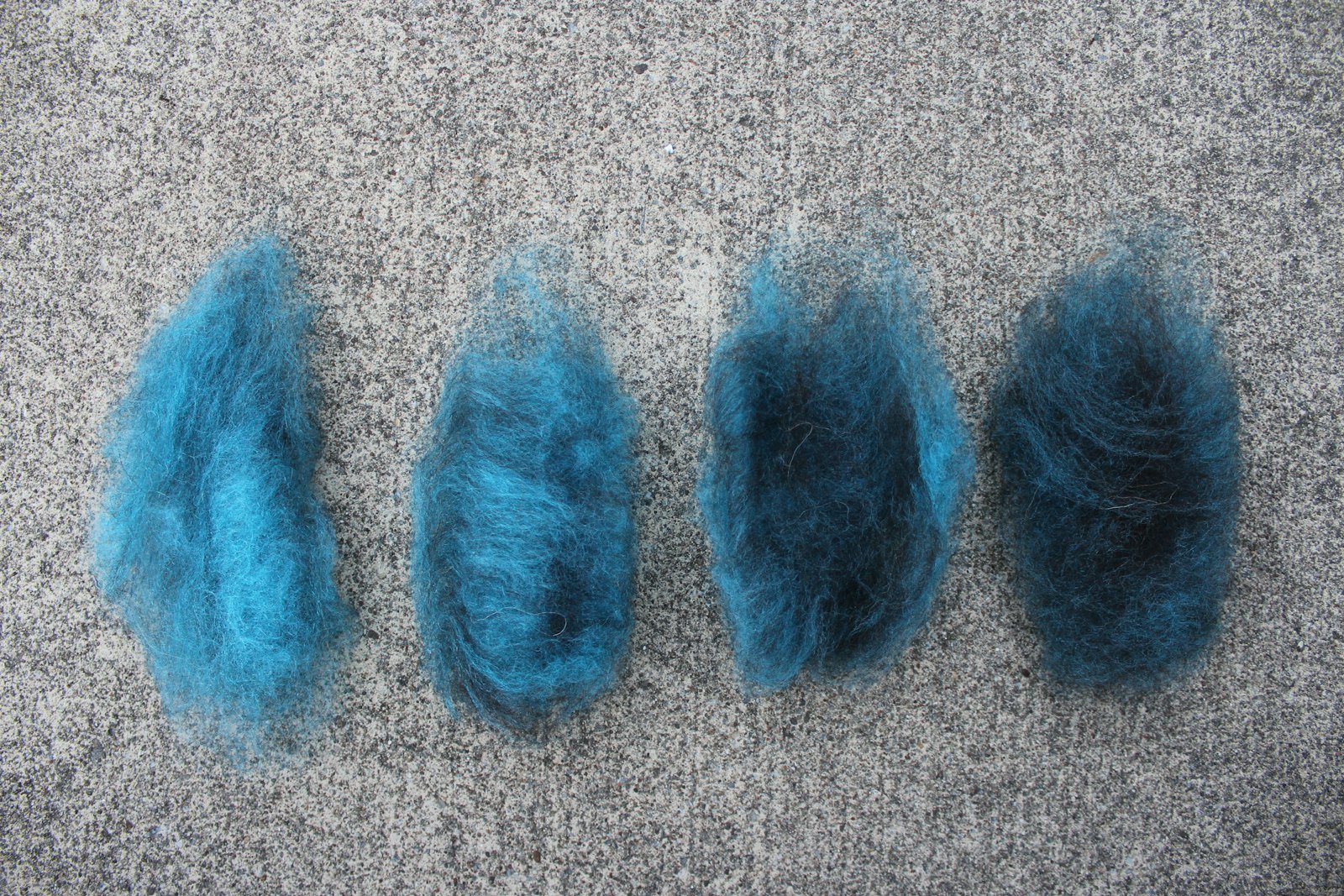Cinema is the inspiration for this exploration of adding black to your fibers. In the 1940s and 1950s, Hollywood made gorgeous films in the crime and thriller genre which later came to be called “film noir.” “Noir” in French means black, and in the case of these black-and-white films, the absence of color was what made them so creative and fascinating. The cinematography and mood were fatalistic and suspenseful, and this was all accomplished with shadows and light.
Black tends to intimidate many handspinners. Yet, like “film noir,” it can be a powerful, creative tool to bring out richness and add depth to fibers that would otherwise be a bit plain and one-dimensional. We want the mystery, the power, and the timeless elegance that black brings. We don’t want muddied or lost colors—these are the hazards of blending with black.
Let’s remove the intimidation and study the blending of black fibers in various increments with fibers in the primary colors: blue, red, and yellow. There is no limit to the colors you can use, but by focusing on the primary colors, you will have a good base from which to branch out and experiment.

A circle of primary-colored mini-batts blended with black for comparison and inspiration. All photos by author.
Meet the Fibers
The blue roving is made of wool with sparkly nylon hints. The red and yellow rovings are also wool. The black roving is a blend of alpaca and American Black Welsh Mountain sheep wool. What makes the black roving especially rich and beautiful is the fact that it is made from undyed naturally-black fibers. Both fiber types are considered true black, which is rare.
I made four one-ounce samples of each primary color (blue, red, and yellow), for a total of 12 samples.
For each color, I added black fibers at increments of approximately 10%, 20%, 30%, and 40%. I used handcards to carefully blend each sample until I achieved the desired blend without over-carding the fibers. I made mini-batts from my carders and spun them directly into my wheel using a short-forward draw. I plied all my singles to make 12 mini-skeins of balanced, semi-woolen 2-ply yarns.

All 12 yarn samples in a row for study. Note the gradations of color from less to more black.
Finally, I made small knit samples from all 12 mini-skeins to observe the final color blends.

A circle of primary-colored knit samples blended with black to compare and enjoy.
Blue Fade to Black In describing the samples from 10% to 40% black, the black was barely noticeable in the 10% and 20% mini-batts. At 30% and 40%, the black was very noticeable in the batts. When I spun the batts into yarn, the black emerged as a positive color enhancer for all the samples. The black made the blue pop, and that pop was maximized at the 10% and 20% levels. Seeing the color in a handspun sample might be enough to determine your desired level of blending. To take your analysis a step further, you may want to knit a small sample to see the yarn as a fabric. This can help you see whether the level of black will accomplish your goals for your knit project.

Fibers, yarn and knit sample in blues from 10-40% black from left to right.
Red Fade to Black As black was added to the red fibers, black seemed to take over the red mini-batts. When spun into yarn, however, the red popped until the 40% blend. The knitted samples reflected the same blend behavior, with glowing red for the 10%, 20%, and 30% levels. At 40%, the black overtook the red.

Fibers, yarn and knit sample in reds from 10-40% black from left to right.
Yellow Fade to Black A different picture emerged for the yellow fibers. At the mini-batt stage, the yellow was visible, and it seemed to mirror the other colors in effect. When I spun the blends into yarn, the yellow disappeared! Yellow blended with black shifted to a green hue with black highlights. If you wish to preserve the yellow, the blend may only tolerate single-digit percentages of black or very little blending prior to spinning. The effect will also depend on the gauge that you spin. This is a great example of why it is important to pull out your handcards and give it a try yourself!

Fibers, yarn and knit sample in yellows from 10-40% black from left to right.
Final Thoughts
Blending increasing amounts of black revealed the power of black and the limits of black. While each of the primary colors had unique responses to blending, the overall effect was transformative. I felt that each primary color went from bland to glowing. In these samples, 40% black emerged as the outer limit of blending, where amounts over that would become black fibers with color highlights, instead of black acting as an enhancement to the primary color.
When seeking to add black to your color blend, the best way to take control of the process is to make a small sample of yarn with the percentage of black that you think would create the yarn you envision. The yarn sample, even if less than an ounce, will reveal the impact, and you can adjust from there. You have the option of knitting the sample yarn into a swatch, to further predict the behavior of black in your blend.
Movies usually fade to black in the last scene to signal the end of the story. For handspinners, a fade to black means the exact opposite—it is just the start for you to harness the power of black in your fiber color palette.
Jacqueline Harp is a freelance writer and multimedia fiber artist who spins, felts, weaves, crochets, and knits in every spare moment possible. She is also a certified Master Sorter of Wool Fibers through the State University of New York (Cobleskill) Sorter-Grader-Classer (SGC) Program. Her Instagram handle is @foreverfiberarts.

